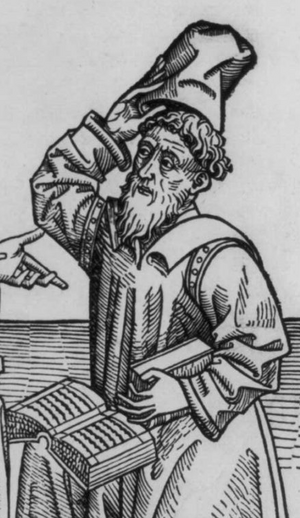Borzuya facts for kids
Quick facts for kids
Borzuya
|
|
|---|---|

Artwork of Borzūya
|
|
| Born | 5th century - 6th century |
| Died | 6th century |
| Education | Academy of Gondishapur (possibly) |
| Known for | Translating many books into Pahlavi |
| Medical career | |
| Profession | Physician |
Borzuya (also spelled Burzōē or Borzouyeh) was a famous Persian doctor. He lived a long time ago, during the late Sassanid era in Persia. This was when Khosrau I was king. Borzuya is best known for translating an important book from India.
He translated the Indian book called Panchatantra. This book was originally in Sanskrit. Borzuya translated it into Pahlavi, which was the language spoken in Persia then. Sadly, both his translation and the original Sanskrit version are now lost.
However, before they were lost, Borzuya's Pahlavi version was translated again. It was translated into Arabic by a scholar named Ibn al-Muqaffa. This new Arabic version was called Kalila and Dimna or The Fables of Bidpai. It became a very important book in classical Arabic writing.
Contents
What is Kalila and Dimna?
The book Kalila and Dimna is a collection of fables. Fables are stories that teach a lesson. In these stories, animals talk and act like people. They interact in clever ways to share important lessons. These lessons were often about how to rule or make good decisions. They were meant to teach princes and leaders.
Borzuya's Amazing Journey
The introduction to The Fables of Bidpai tells us about Borzuya's life. It shares his thoughts and how he grew as a person. It shows that he became a doctor to help people. The story also tells how Borzuya searched for truth. He even questioned common religious ideas of his time.
Borzuya traveled to India around the year 570 CE. He went there to find a special "elixir." He thought this elixir could bring the dead back to life. But a wise philosopher in India taught him something important. The philosopher explained that the "elixir" was not a real potion. It was actually a metaphor for the Panchatantra book itself. The book's wisdom could "revive" minds.
How Borzuya Copied the Book
Borzuya then asked the King of India for permission to read the Panchatantra. The king allowed him to read it, but he could not copy it. Borzuya was very clever. He found a way to make a copy without directly breaking the rules.
Each day, Borzuya would read one chapter of the book. After reading, he would go back to his room. There, he would write down everything he remembered from that chapter in his journal. This way, he slowly created his own copy of the entire Panchatantra. Once he finished, he sent his copy back to Persia to be translated.
Was Borzuya the Same as Bozorgmehr?
There has been a lot of discussion about whether Borzuya is the same person as another famous figure named Bozorgmehr. Most sources say they were different people. However, the name "Borzuya" can sometimes be a shorter version of "Bozorgmehr." So, it's a bit confusing!

